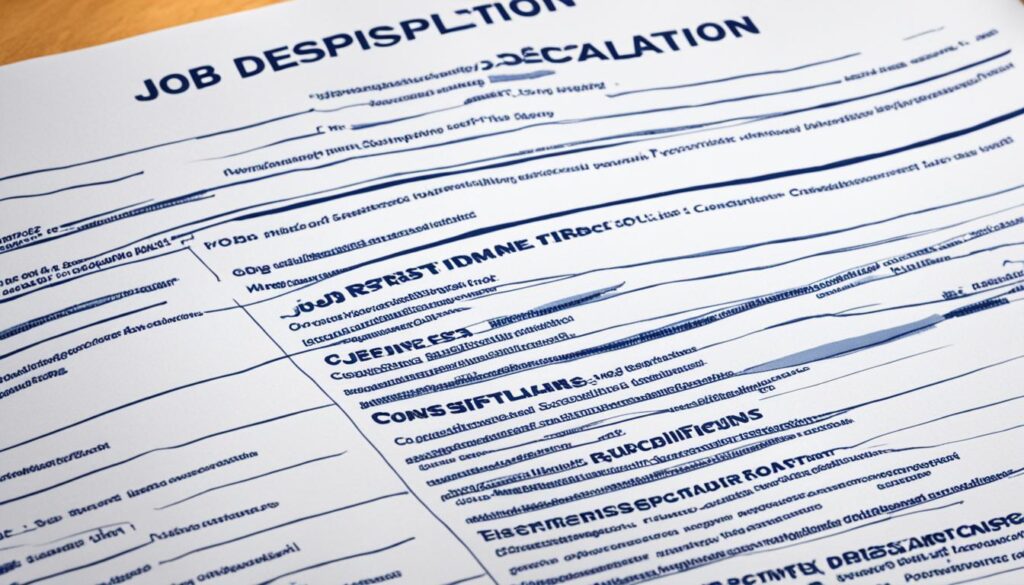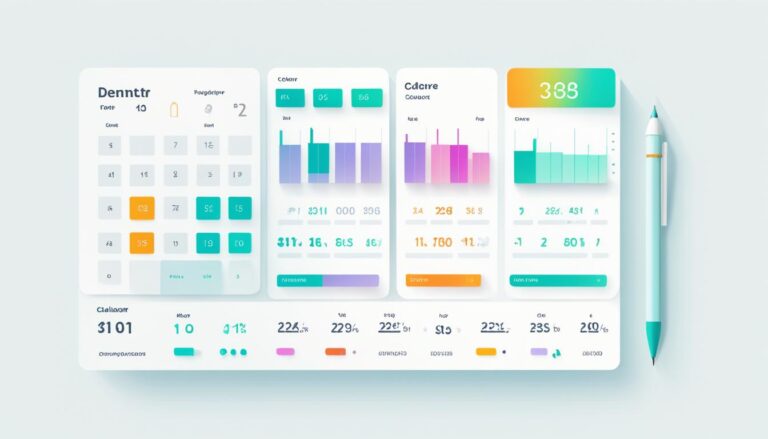Boost Your Worker Productivity Today!

Are you struggling to increase productivity at work and optimize your workforce performance? Do you find that your employees’ efficiency needs improvement? If so, you’re not alone. Many businesses face the challenge of enhancing workplace productivity and maximizing employee output. But what if there were proven strategies and tools to boost labor productivity and enhance workplace efficiency?
Discover the secrets to improving worker productivity and achieving desired outcomes in this comprehensive guide. Explore efficiency improvement strategies, maximizing employee productivity, and workforce productivity tools that will revolutionize the way you work. Whether you’re a small business owner or a corporate leader, these insights will help you unleash the full potential of your workforce.
Key Takeaways:
- Understanding the factors that affect worker productivity
- Measuring and evaluating the current productivity levels of your team
- Defining productivity goals specific to your organization
- Creating clear job descriptions to improve employee satisfaction
- Implementing effective management practices to enhance workplace productivity
Understand the Current Productivity Levels of Your Team
Before making any adjustments to productivity, it is essential to measure the current productivity levels of your team. By evaluating financial goals, business goals, and individual SMART goals, you can gain insights into the effectiveness of your team’s efforts and identify areas for improvement.
Measuring productivity allows you to establish a baseline and track progress over time. It provides valuable data that can inform decision-making and help you set realistic targets. By monitoring productivity levels, you can identify trends, recognize patterns, and implement strategies to optimize performance.
One way to measure productivity is by setting financial goals and tracking the achievement of those goals. Determine key performance indicators (KPIs) that align with your business objectives, such as revenue generated, cost savings, or profit margins. Regularly assess your team’s performance against these financial goals to assess productivity levels and identify opportunities for improvement.
Another approach is to evaluate business goals and assess their progress. Break down overarching goals into smaller, manageable objectives that are specific, measurable, achievable, relevant, and time-bound (SMART). Regularly review and analyze the progress of these goals to gauge productivity levels and determine areas that require attention.
Individual SMART goals are also crucial in measuring productivity at the employee level. Work with your team members to establish specific goals that align with the overall objectives of the organization. Regularly assess their progress and provide feedback to ensure they are on track. This individual assessment contributes to understanding the collective productivity of your team.
By utilizing productivity strategies and implementing the tips provided in this article, you can track the progress of your organization and assess the improvements in productivity. Remember, measuring productivity is not a one-time task but an ongoing process that allows you to continuously optimize your team’s performance.
| Key Metrics | Data Collection Method | Frequency |
|---|---|---|
| Financial goals | Accounting reports, sales data | Monthly/Quarterly/Annually |
| Business goals | Progress reports, project updates | Monthly/Quarterly/Annually |
| SMART goals | Goal tracking software, performance reviews | Monthly/Quarterly/Annually |
Define Your Organization’s Productivity Goals
To enhance employee productivity, it is crucial to define productivity goals specific to your organization.
When employees have a clear understanding of what is expected of them and the direction the company is heading, they are more motivated to be productive. Clearly communicating SMART goals, core values, and the company’s purpose ensures that employees are aligned with the organization’s mission.
SMART goals, which are Specific, Measurable, Achievable, Relevant, and Time-bound, provide employees with a clear roadmap of what needs to be accomplished and by when. This level of clarity helps employees stay focused and prioritize their tasks.
Creating a mission statement that captures the essence of your company’s purpose and values provides employees with a sense of meaning and direction. It gives them a deeper understanding of how their work contributes to the overall success of the organization.
Aligning each department with a department manifesto that reflects the company’s values and goals can further enhance employee engagement. It ensures that every department is working towards a common purpose and fosters a sense of unity and collaboration among teams.
By defining productivity goals, communicating SMART goals, crafting a mission statement, and aligning departments with a department manifesto, you create an environment where employees feel connected to the company’s purpose and are motivated to give their best.
Key Takeaways:
- Define specific, measurable, achievable, relevant, and time-bound (SMART) goals.
- Communicate the company’s mission, core values, and purpose to employees.
- Create a mission statement that captures the essence of your company’s purpose.
- Align each department with a department manifesto that reflects the company’s values and goals.

Having a clear vision and direction is essential in guiding employees towards improved productivity and overall success.
Create Clear Job Descriptions
Clear job descriptions are a fundamental aspect of achieving employee satisfaction and maximizing productivity within your organization. When employees have a clear understanding of their roles and responsibilities, they can effectively focus on their tasks and contribute to the overall success of the team. By reviewing job descriptions with employees, you can identify areas where they excel, tasks they would delegate if possible, and any discrepancies between the description and the actual responsibilities.
This open communication allows you to ensure that job descriptions accurately represent the nature of the role and align with employee skills and interests. By incorporating employee feedback and making necessary adjustments, you can create a work environment that fosters job satisfaction and empowers individuals to perform at their best.
Key Benefits of Clear Job Descriptions:
- Enhanced Employee Satisfaction: When employees have a clear understanding of their job expectations, it leads to increased job satisfaction and a sense of fulfillment.
- Delegating Tasks: By identifying tasks that employees would delegate if possible, you can redistribute workload and optimize productivity.
- Improved Efficiency: Clear job descriptions ensure that employees have a well-defined scope of work, reducing confusion and promoting efficient completion of tasks.
- Task Prioritization and Balancing Responsibilities: When employees understand their role, they can effectively prioritize tasks and balance responsibilities, improving overall productivity.
Take the time to regularly review and update job descriptions to reflect changes in roles, responsibilities, and organizational needs. By creating clear job descriptions, you provide the foundation for employee satisfaction, effective task delegation, and the successful balance of responsibilities.

Focus on Effective Management Practices
Effective management practices are crucial for enhancing workplace productivity. Instead of solely focusing on improving the productivity of individual team members, adopting a top-down approach that assesses managerial competence is essential. By evaluating managers’ ability to meet goals and addressing any areas of improvement based on feedback from team members, organizations can significantly impact employee morale and overall productivity.
A culture of accountability is key to fostering productivity. When managers hold themselves and their teams accountable for achieving targets, it creates a sense of responsibility and commitment. Employees feel motivated to contribute to the team’s success and strive to meet or exceed expectations.
To further enhance productivity, it is important to recognize and value the contributions of all team members. Managers should create an environment where every team member’s input is valued and encouraged. By fostering a culture of collaboration and inclusivity, employees are more likely to feel engaged and committed to their work.
Additionally, providing opportunities for professional development and growth can contribute to managerial competence and employee morale. Offering training programs and mentorship opportunities allows managers to enhance their skills and knowledge, which in turn positively impacts their ability to lead and motivate their teams.
An effective management approach that prioritizes employee morale, accountability, and team contribution will result in higher employee engagement and increased productivity. By focusing on improving managerial competence and creating a supportive work environment, organizations can optimize workforce performance and drive success.

Prioritize Employee Health and Well-Being
Employee health and well-being play a crucial role in fostering productivity and creating a positive work environment. When employees are physically and mentally healthy, they can perform at their best and contribute significantly to the success of the organization. To ensure the well-being of your workforce, consider the following strategies:
Promote Preventative Care
One effective way to prioritize employee health is by providing access to proper health insurance that covers preventative care appointments. Encourage your employees to schedule regular check-ups and screenings to detect any potential health issues early on. By focusing on preventative care, you can reduce the likelihood of employees taking unplanned time off due to preventable illnesses.
Implement Wellness Programs
Wellness programs can greatly contribute to improving the overall health and well-being of your employees. Consider offering virtual fitness classes, where employees can participate in exercise sessions from the comfort of their homes or office. Additionally, offer health education classes that cover topics such as nutrition, stress management, and maintaining a healthy work-life balance. These programs not only promote physical health but also provide valuable resources for managing mental health and reducing workplace stress.
Address Mental Health
Mental health is equally important as physical health when it comes to employee well-being and productivity. Recognize the impact of stress, anxiety, and depression on employee performance and create a supportive environment where mental health is openly discussed and prioritized. Offer resources such as counseling services or employee assistance programs to provide necessary support for employees facing mental health challenges. By addressing mental health concerns, you can empower your workforce to thrive both personally and professionally.
| Benefits of Prioritizing Employee Health and Well-Being |
|---|
| 1. Increased employee engagement and satisfaction |
| 2. Reduced absenteeism and improved attendance |
| 3. Enhanced productivity and performance |
| 4. Lower healthcare costs in the long run |
| 5. Positive company culture and employee morale |
By prioritizing employee health and well-being, you can create an environment that fosters productivity and supports the overall success of your organization. Investing in your employees’ physical and mental health is not only beneficial for them individually but also for the collective growth and prosperity of your business.

Conclusion
In summary, improving worker productivity is crucial for enhancing workplace efficiency and promoting better employee performance. By implementing the strategies discussed in this article, you can create a more productive work environment and maximize the output of your workforce.
First and foremost, understanding and measuring current productivity levels allows you to establish a baseline and track progress. Setting clear productivity goals aligned with your organization’s mission and values is essential for motivating employees and driving them towards success.
Clear job descriptions provide employees with a sense of purpose and direction, ensuring that everyone understands their roles and responsibilities. Additionally, effective management practices that prioritize accountability and value team contributions can significantly boost employee morale and productivity.
Furthermore, prioritizing employee health and well-being through initiatives such as wellness programs and stress management tools can create a positive work environment and improve overall performance. Lastly, investing in the right tools and technology equips your workforce with the resources they need to excel in their roles.
In conclusion, by focusing on worker productivity and implementing the strategies outlined, you can optimize workforce performance, enhance workplace efficiency, and ultimately improve employee performance. With a committed approach to productivity improvement, your organization can achieve greater success and drive towards a more productive future.






